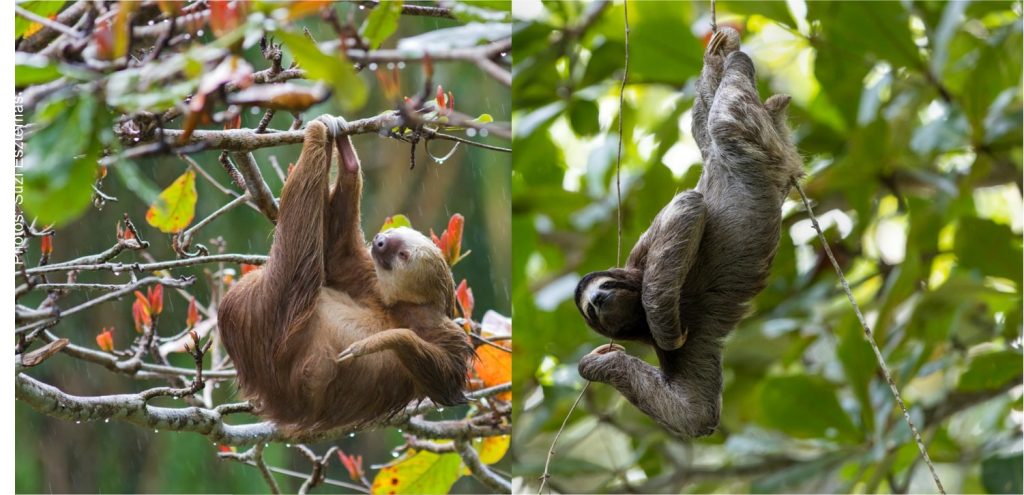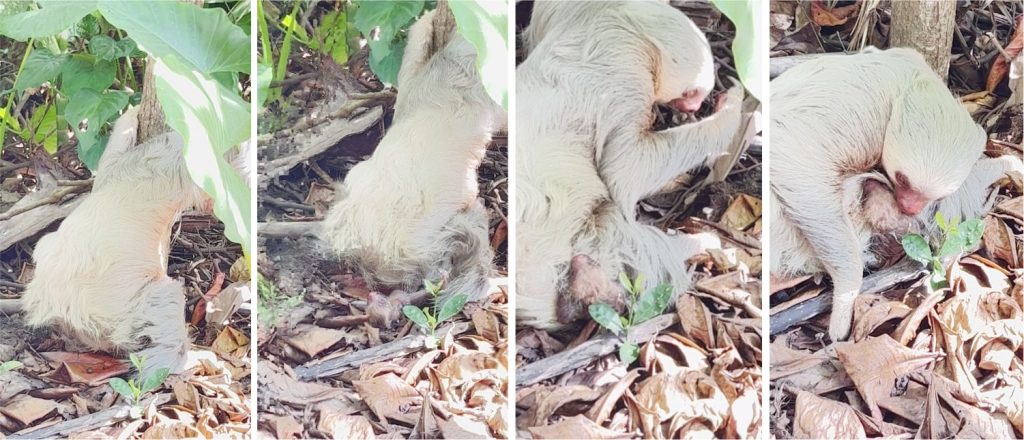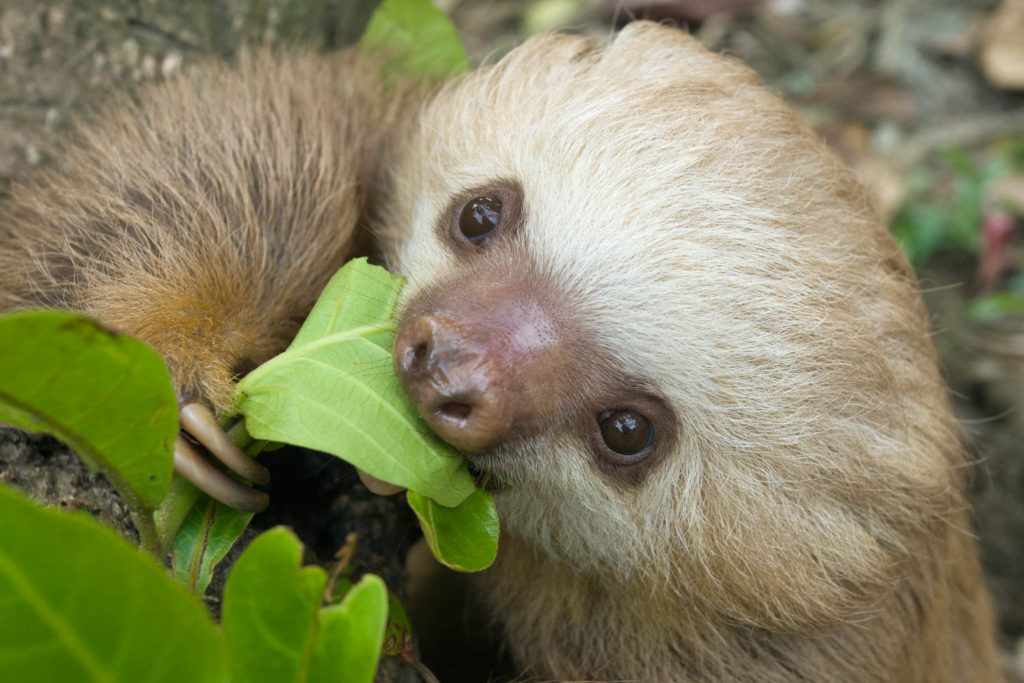Baby Sloths: everything you always wanted to know!
A baby sloth is fully reliant on it’s mother to teach it how to survive in the canopy of the rainforest. They are fragile yet fascinating little creatures, and here you can learn everything you ever wanted to know about baby sloths!
Giving Birth to a Baby Sloth
A two-fingered female sloth will give birth to a single baby after a gestation period of 11.5 months, while a three-fingered sloth is thought to give birth after approximately six months. Biologists have never had the opportunity to follow a three-fingered sloth all the way from conception to birth, and so this gestation period is still only an approximation.
When it’s time to give birth, the mother will usually descend to the lower canopy branches and give birth while hanging upside down. In this position, if the baby falls to the ground, it won’t fall far, and the mother can climb down to retrieve her young.
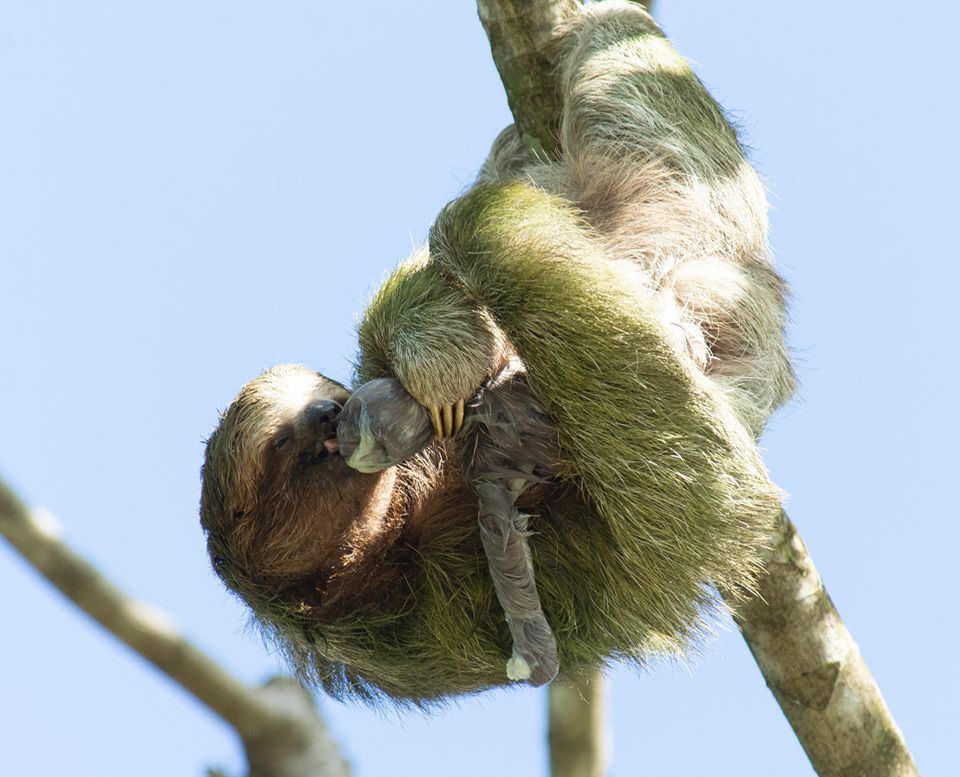
The afterbirth usually falls to the forest floor and female sloths have been known to descend to the ground to consume it – it is very common for animals in the wild to ingest the afterbirth, even herbivores like sloths, probably for a nutritional boost or to avoid attracting the attention of predators.
Ver esta publicación en Instagram
Occasionally, sloths have been known to give birth to twins, but there is only enough room on the female’s chest for one baby and the sloth’s very slow metabolism only provides enough resources for one, so the weakest twin will usually be rejected.
Baby Sloth Features
A baby sloth is born ready to face the world with eyes open, sharp claws, and fully formed teeth. It will instinctively cling to it’s mother’s fur immediately after birth and crawl up towards the safety of her chest where she begins the process of cleaning the young with her mouth.

The weight and size of baby sloths differs between the six extant species. Three-fingered sloths are smaller than two-fingered sloths. A newborn baby sloth typically weighs between 300 – 500 grams, with three-fingered babies often weighing less than two-fingered babies.
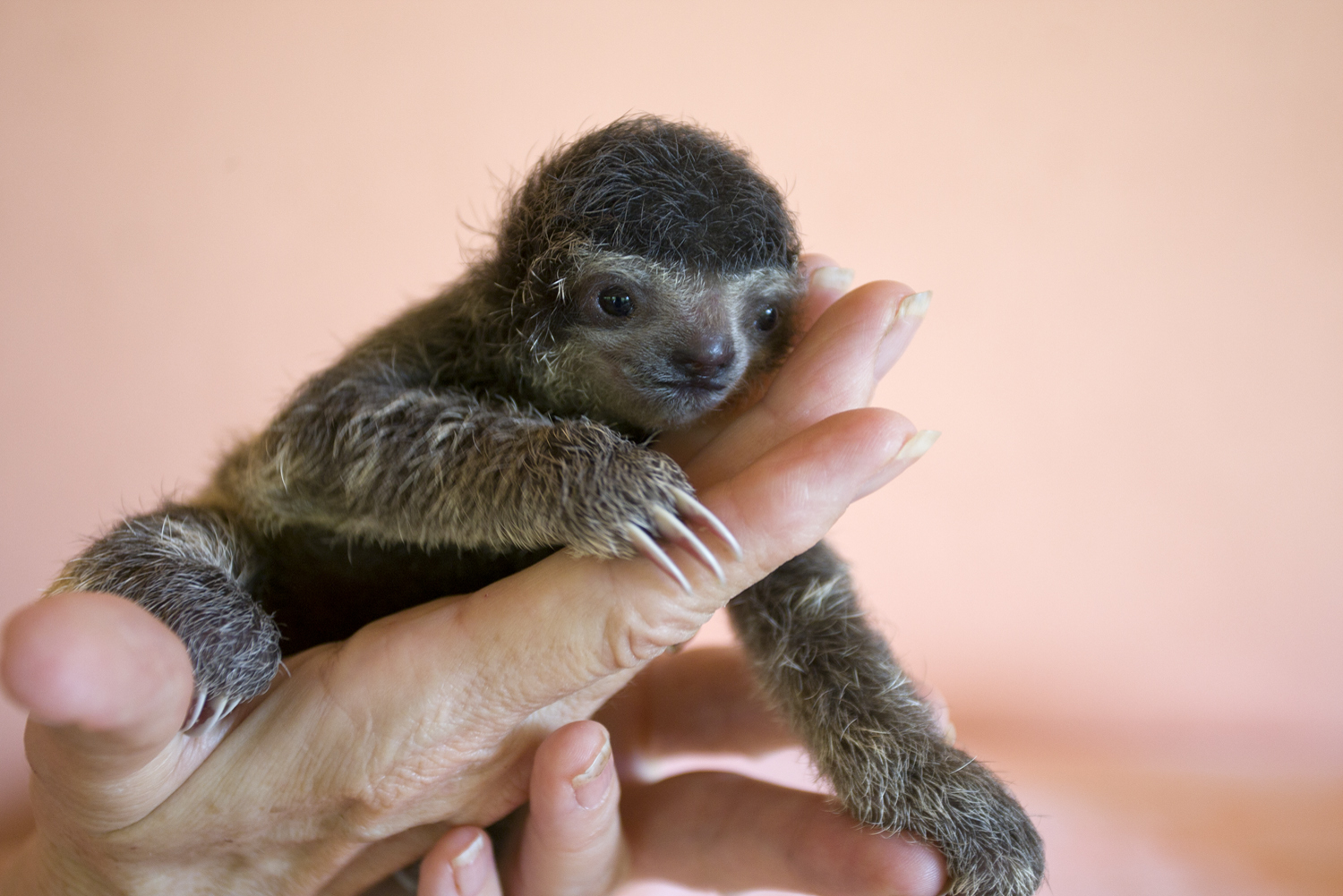
How much do baby sloths sleep?
Despite the common myth that a sloth will sleep for 20 hours per day, adult sloths in the wild actually only sleep for an average of 8 to 10 hours per day.
Currently, no research has been conducted into the sleeping habits of wild baby sloths, however, if we extrapolate data from other mammals, we can hypothesize that baby sloths will sleep for a larger portion of the day than adults as they do not have to be on the constant lookout for predators or forage for food – their mom’s do that for them!
Adult and baby sloths in human facilities (zoos/rescue centers) sleep for an average of 15 hours per day.

Read More: How much do sloths sleep?
Raising a baby sloth
Male sloths, as with most mammals, don’t care for their young. The female sloth will spend up to 12 months of her life raising her baby alone.
The baby clings on the mother’s chest for approximately six months, regularly suckling small amounts of milk throughout the day.
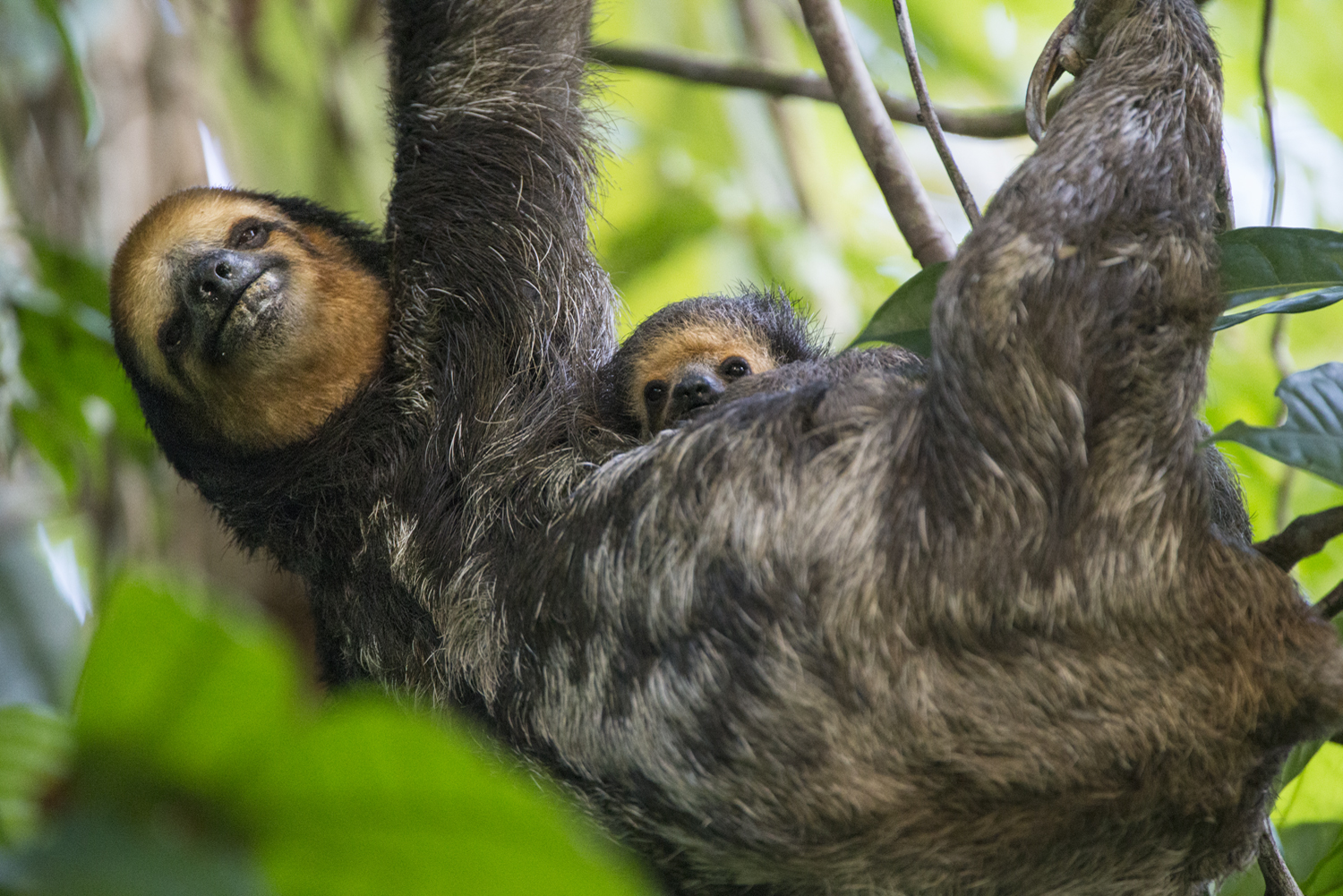
Sloth mothers don’t store large amounts of milk like most other mammals – carrying a heavy supply of milk around is expensive in terms of energy. Because baby sloths are always clinging onto their mother’s chest, females save energy by slowly producing small amounts of milk throughout the day instead.
As well as drinking milk, baby sloths will begin to sample leaves from around their mother’s mouth from as early as 1 week old – this is how the baby learns which leaves are good to eat!

Exploring with mom
While young baby sloths usually spend the majority of their time on their mother’s chest, they will occasionally cling onto the fur on her back. This usually happens while she is crawling across the ground, however, as the baby grows it will begin to move around more, and will often take this opportunity to explore what is going on around mom.
At first, this will be reaching out to grab different leaves and branches with two or three limbs, still maintaining a connection with mom, but as the baby slowly gains confidence (and becomes too heavy for mom to carry), they will spend an increasing amount of time next to mom, rather than clinging to her.
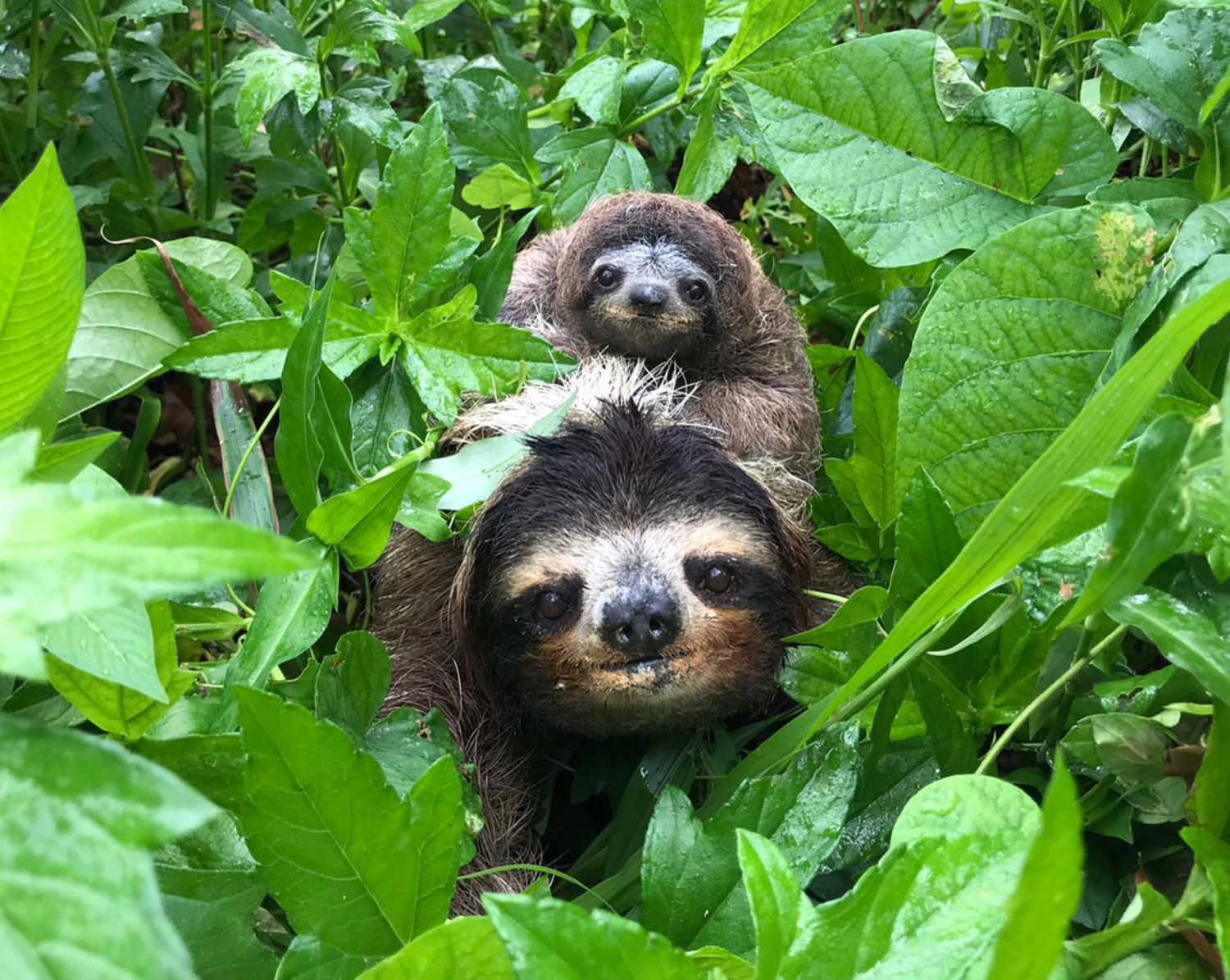
Learning to poop
Once a week, the mother will climb down to defecate at the base of a tree. The baby sloth will start pooping following the patterns of the mother.
The ‘poop dance’ is something that all sloths do immediately before and after they defecate, and it involves wiggling around at the base of the tree. This dance helps them to clear a space in the leaf litter for them to defecate into, and then cover up the evidence of their weekly journey to the ground afterward. Three-fingered sloths are particularly good at this as they have a short stubby tail that helps to dig a deeper hole!
Read more: Why do sloths really poop on the ground?
Falling from the trees
Sometimes a baby sloth will fall from its mother’s chest to the ground where it is very vulnerable to predators.
Sloths are built to survive falls of up to 100ft to the forest floor – however, they are not adapted to fall onto concrete or roofs. As more of their jungle home disappears, sloths are less likely to survive falls.
When a baby sloth falls and becomes separated from mom, they will cry to alert their mother to where they are. Mom will climb down from the canopy to retrieve her baby, but as sloths have a top speed of 2mph, this journey will take a lot of time and energy.

Reuniting with mom – with the help of humans!
In urban areas, well-meaning members of the public may assume that a baby sloth on the ground is in trouble, and will take them to a rescue center before mom has the chance to reach her baby. Rescue centers have developed a technique to reunite mothers with their babies in these situations, by recording the baby’s cry and playing the recording on a loudspeaker where the baby was discovered.
Baby sloth cries are loud, but the jungle is louder (especially in urban areas where cars and construction noise pollute the air). If mom is still around, she will spring into action and slowly head towards the cry coming from the loudspeaker. The lost baby can be placed on the tree trunk once mom is close enough, and mom can scoop her baby up and return to the canopy.

However, if a baby falls from mom too many times, mom may stop retrieving them. This is because a mother will perceive something wrong with a baby who cannot hold onto her fur consistently, and with survival being the name of the game in the wild, a mother who has an indication that her baby is not completely healthy is likely to reject them.
There have been reports from rescue centers that mother sloths have come down from the canopy to their babies, only to sniff them and climb back up without the baby, showing the baby sloth has been truly rejected by the mother. In this case, there is a high risk that the baby has congenital abnormalities. Not to mention, climbing up and down from the canopy repeatedly exerts a large amount of energy from a sloth who does not have much to spare!

What should you do if you find a baby sloth close to the ground? Keep watch until nightfall, unless the baby is in immediate danger from predators. If 12 hours have passed with no sign of the mother, please contact your local rescue center.
Crying Baby Sloth
Sloths are usually silent creatures as their greatest survival techniques are camouflage and stealth. However, baby sloths will call for mom when they are separated, and this creates some of the cutest sounds and noises imaginable.
Three-fingered baby sloths make a high pitch squeak, while two-fingered babies sound like baby goats (they ‘meep’).
Baby Sloth Diet
As a baby sloth grows, it learns what to eat by copying exactly what its mother is eating. At first, the baby will eat the food from around the mother’s mouth. As it gets older, it will begin to reach off of her body to grab leaves for itself while she is feeding. Through this process, the baby sloth will learn essential lessons about which tree species are safe to eat.

Although sloths are known to feed from more than 90 different tree species, an individual will rotate among approximately seven to 12 favorite feeding trees – a strategy that prevents them from overeating specific toxins present in the leaves. When babies begin to eat leaves fresh from the trees, rather than mulch from their mom’s mouths which are already partially broken down due to enzymes in her saliva, mom will direct her baby to the youngest, most tender leaves of the tree.

Not only do these young leaves have lower levels of any potential toxins, but the cellulose cell wall of the plant is less well established in young leaves, making them easier to digest.
Due to their incredibly slow metabolism and rate of digestion, if sloths were to feed from the same tree species for too long, it is thought that they would intoxicate themselves. Sloths learn this behavior and inherit their feeding tree preferences from their mothers, which may be why releasing hand-reared sloths into the wild can be particularly difficult.

Green Offsprings
Baby sloths will look very different from their mothers when they are born. Adult sloths tend to have some algal and fungal growth on their outer fur, whereas babies are born with only the soft, downy undercoat. They develop coarse outer fur at sexual maturity.
Wild sloths begin to develop their green color after approximately 18 months, as algae, fungi, and insects pass from mother to offspring. For this reason, sloths raised in captivity do not develop the famous green coloration, as they are not interacting with any wild sloths who do have flora and fauna growing on their fur.

Read More: Sloth hair, algae, fungi, and moths
Becoming Independent
At about six months old, the baby sloth will begin to venture off the mother’s body and spend more time hanging out close by. As independence draws closer, the distance between mother and baby slowly grows.
Eventually, the mother sloth will completely leave her original home range and move to a neighboring patch of forest. This is an unusual method of separation for a mammal, as typically the baby is expected to disperse and establish a territory elsewhere.

Three-fingered sloths weigh 1 – 1.5kg once they reach independence, while two-fingered sloths weigh closer to 2kg.
After separating from its mother, the juvenile sloth becomes solitary and will only choose to interact with others when finding a mate. And now the baby sloth life cycle is completed.
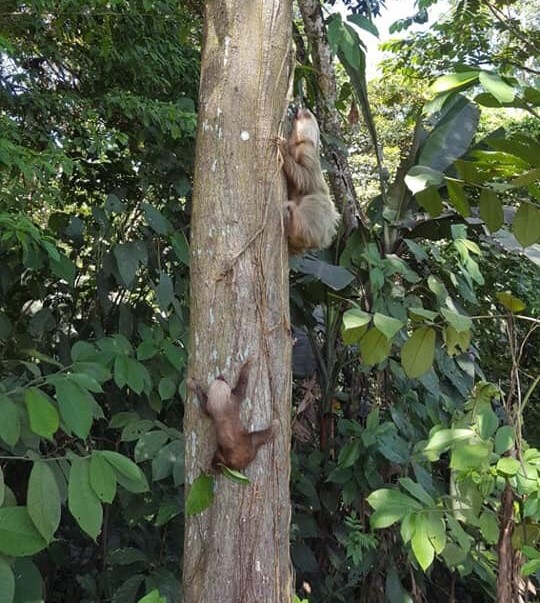
A rare case: three-fingered sloth ‘adopts’ a two-fingered sloth baby
Cross-species adoptions in the wild are exceptional events, and very rare to see. At the end of 2020, we received a highly unusual report of a three-fingered female that adopted a two-fingered baby in Costa Rica.
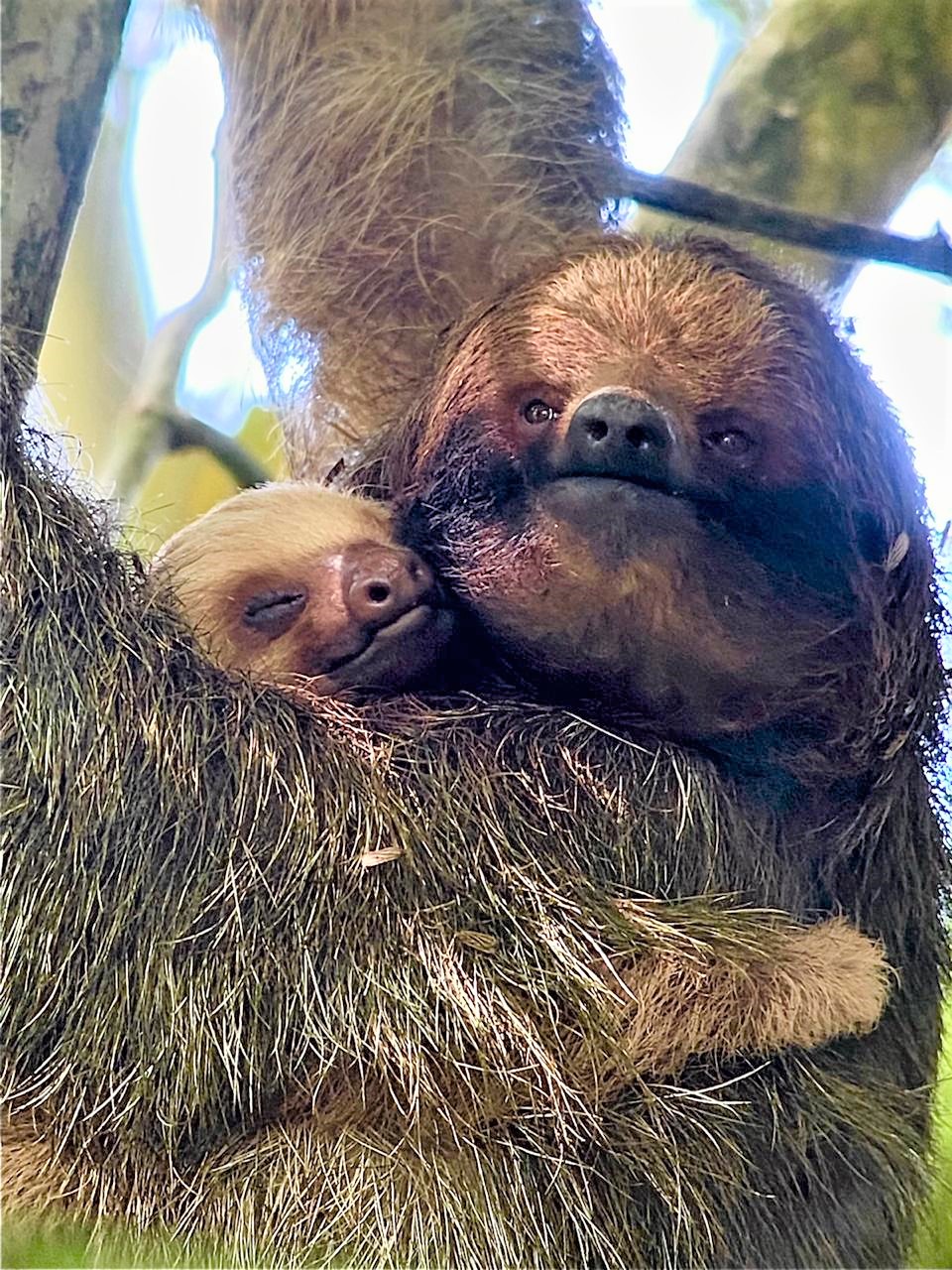
The reasons behind this behavior are still unknown, and at the moment there are no reports of a similar case. According to the naturalists that were following them on a daily basis to gather data and information, they looked very comfortable together. You can read more about this case here.
How to make a baby sloth
Sloths reach sexual maturity at approximately two years old. However, when you are a slow mover without much energy to spare, finding a mate can be difficult.
Female three-fingered sloths have found an unexpected solution to this problem – they scream! When she enters estrus, a female will emit high-pitched vocalizations to attract the attention of males.
Two-fingered sloths do not vocalize. Instead, both males and females mark their scent by rubbing their anal glands against tree branches to send messages about their reproductive status.
While sloths will typically only descend from the canopy to relieve themselves once a week, a female sloth will make the long journey down to the forest floor every single day when she is in estrus. Pheromones present in urine and feces are an incredibly important method of communication for all types of sloths and are likely the reason behind their unusual defecation habits.
What is the name of a baby sloth?
There are a lot of names for babies of different animal species: calf, kitten, fawn, cub, piglet, duckling, etc… but we don’t yet have a specific name for a baby sloth! Scientists, biologists, and zoologists usually use the generic words ‘offspring’, ‘young’, and ‘baby,’ of course.
The Sloth Sanctuary of Costa Rica suggests the word ‘Slowbie’ to refer to a baby sloth.

Read More: What do you call a group of sloths?
Baby sloths in captivity
Raising rescued young sloths in the nursery, a rescue center, or zoo is difficult for a variety of reasons.
No one has collected a large enough sample of sloth milk for thorough analysis, as mothers produce milk drop by drop as needed by their baby. This makes it very difficult to know what rescue centers should be feeding orphaned babies!
Most have found that a mixture of mineral water, pureed vegetables, powdered goat’s milk, and supplements can provide an alternative for orphaned sloth babies.
Sloths are not able to digest the large fat particles found in cow’s milk, and so this can be fatal if fed to them by mistake.

As mentioned above, sloths eat a wide variety of leaves, and it can be a long process to find the right leaves for each sloth. The broadness of their palate is hypothesized to correlate with the trees the baby was sampling from their mom’s mouth. Choosing leaf species present in the area the sloth was found can help with picky eaters, however, rescue centers are limited by time and resources, and the selection of leaves is based on the availability of trees in the proximity of the rescue center.
In addition, baby sloths will often refuse to eat older leaves (which are the most readily available for rescue centers), and the leaves must be freshly cut. This creates a huge daily job for the facility, which takes up a lot of time and resources.
Rescue centers will release the now-rehabilitated adults in areas with an abundance of the tree species they were most fond of in captivity.

Cuddly toys and blankets
Baby sloths cling onto their mother’s fur for the first part of their lives. Baby sloths have a biological need to hold onto things due to the structure of their muscles – it is this characteristic that makes sloths so well adapted for life in the trees!
In captivity, baby sloths do not have their mothers to hold on to, which is an extremely stressful experience for them. Baby sloths calm down immediately when given something to hold on to.
In fact, recording a baby sloth’s cry for the purpose of attempting to reunite them with their mother is often done by simply removing whatever the baby is clinging to. To satisfy this need, a rescue center will use stuffed toys and blankets to replace the mother.
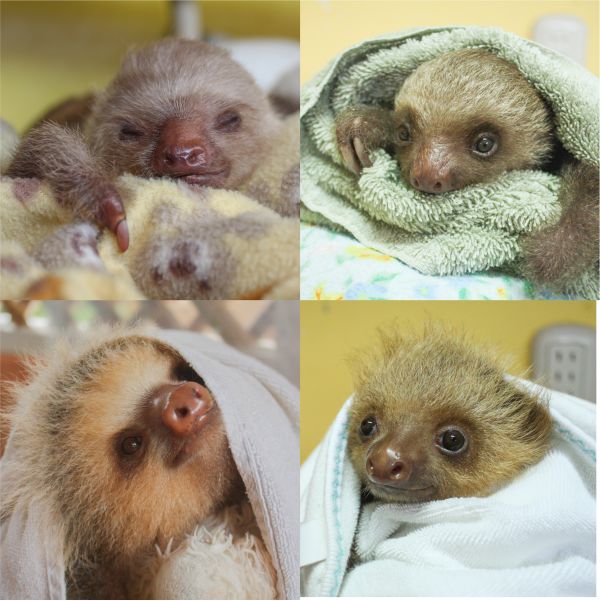
After a quarantine period to ensure the baby is not carrying any disease which can be passed onto other sloths, a common technique is to put several orphaned babies together, where they become like magnets to each other. This not only allows the babies to hold onto another living, breathing sloth but also aids in maintaining their core body temperature.
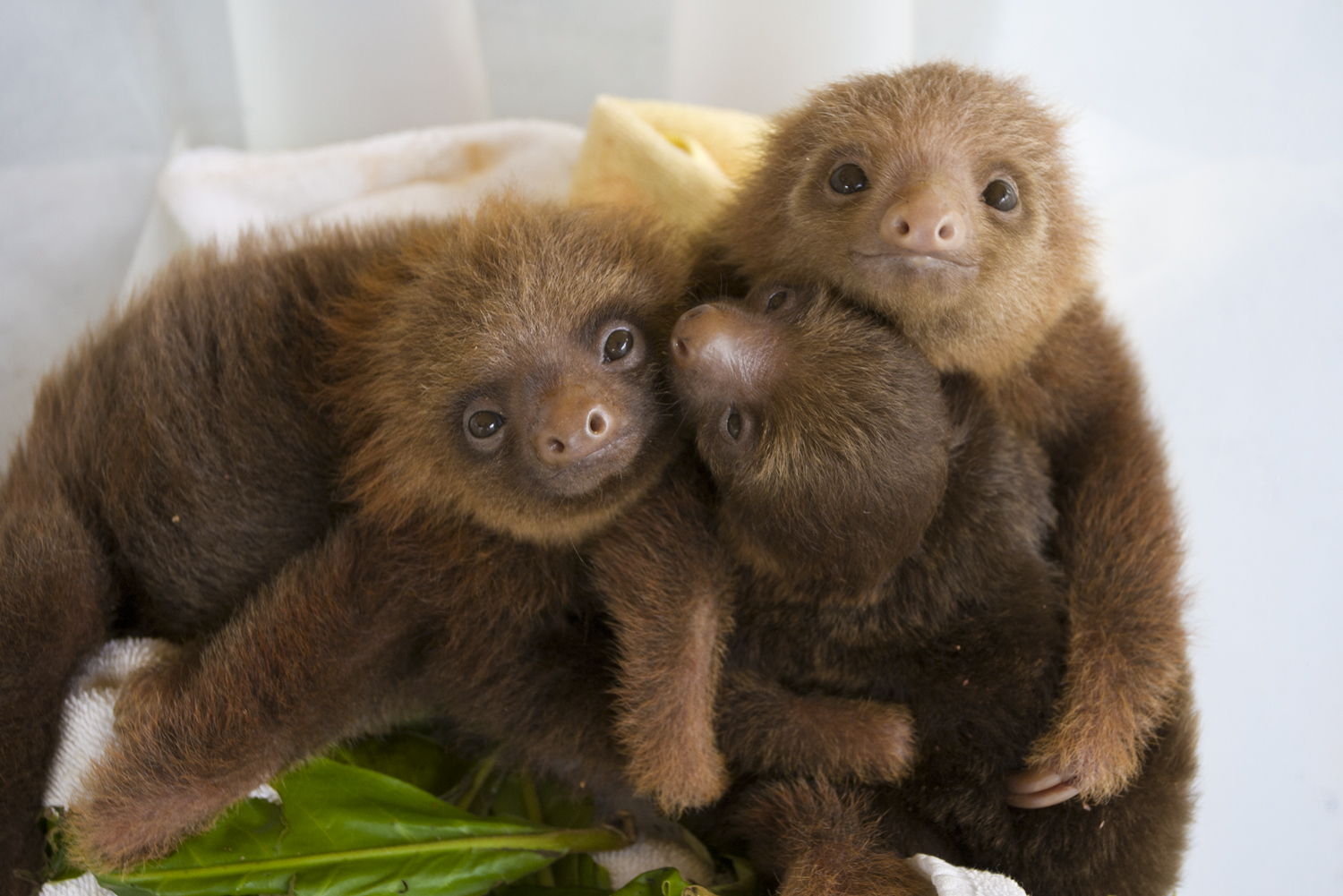
Baby sloth kisses!
It is also quite common to see rescued baby sloths kissing each other. While it’s tempting to anthropomorphize these baby sloth kisses as affectionate, it’s likely that this behavior is being displaced from sharing leaf-mulch from their mother’s mouths. Wild sloths will also sometimes share ‘kisses’ like this which is thought to be a way of transferring important gut bacteria and enzymes that aid in digestion.
Baby sloths are often seen suckling on other baby sloths’ ears, which is also thought to be a displacement behavior from suckling on their mothers in the wild. However, it is likely that baby sloths will only perform this behavior if they are comfortable and experiencing very little stress.

The problem with orphaned baby three-fingered sloths:
Rescue centers receiving orphaned baby three-fingered sloths are still trying to find the correct protocol to raise the species to adulthood and prepare it for release into the wild. There is currently only a handful of institutions that are able to raise orphaned three-fingered sloths successfully, and unfortunately, very few of these have been considered appropriate for release back into the wild.
Zoos featuring sloths only display two-fingered sloths, usually Linnaeus’ two-fingered sloths (Choloepus didactylus). This is because two-fingered sloths are much more successful in captivity than three-fingered sloths, with the Bradypus species having exceptionally short lifespans in captivity.
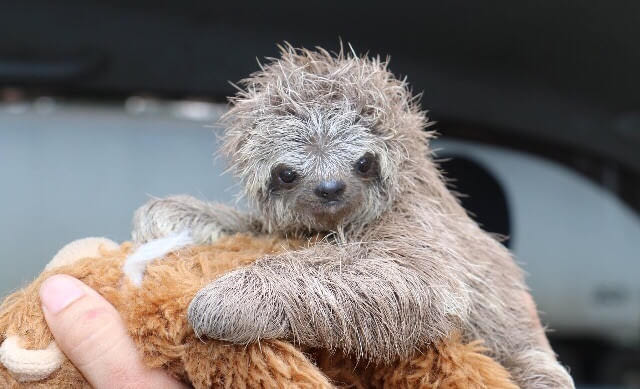
Do baby sloths get used to people?
Sloths do not humanize in the same way as other mammals, and it has not been reported that orphaned sloths raised in captivity become attached to their carers. Sloths do become desensitized to the presence of humans, and current reports from rescue centers that have released captive-raised sloths have shown that these sloths are attracted to the presence of people.
It is not thought that humanized sloths seek out humans for affection, but it is more to do with seeking out what is familiar. Sloths are creatures of habit, and the inappropriate protocols for raising orphaned baby sloths within some rescue centers does not properly prepare them for life in the canopy, leading to an increased amount of human-animal conflict. When platforms and human food, such as vegetables, are provided throughout the raising process, and little preparation for life in the wild is conducted, sloths will often seek out human habitations, as that is what they know to be ‘safe’.

Sloths do not show affection towards people, and in fact, may even actively dislike people. Studies have shown that human physical contact with captive-raised sloths who are desensitized to human presence will still trigger a stress response.
It is for these reasons that rescue centers are advised to have as little physical contact with the sloths as possible, utilizing the babies’ biological need to hold onto something by transporting babies on stuffed toys to avoid any physical contact with their carers. Baby sloths will place themselves on their toys for feeding, replicating the position they would be in to suckle from their mothers.

Can I have a pet baby sloth? Can I buy a baby sloth?
Owning a baby sloth is wrong for a multitude of reasons. Firstly, as mentioned above, it is very hard for even professional wildlife carers to keep baby sloths alive, and raise them for release.
Sloths are not affectionate creatures by nature, and while they may form bonds with each other as babies, this will usually disappear by adulthood. Sloths become extremely stressed when experiencing human contact – their smiling faces are deceptive, they do not show many outward signs of stress. Swiping is one way that sloths exhibit stress, and even this is often misinterpreted by humans as ‘waving.’
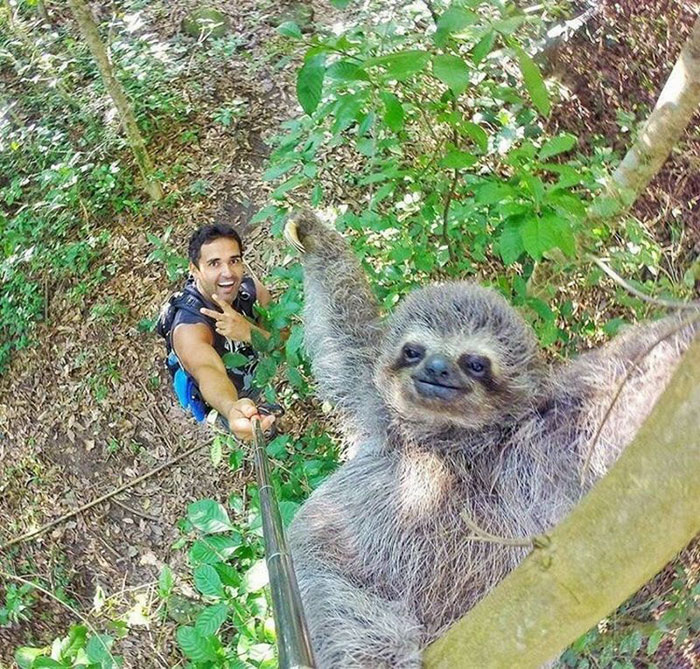
Sloths can be up to three times stronger than a human being, and can cause significant injury to people if given the opportunity. Two-fingered sloths, who fair better in captivity than three-fingered sloths, also have four razor-sharp pseudo canines which will easily slice through human flesh.
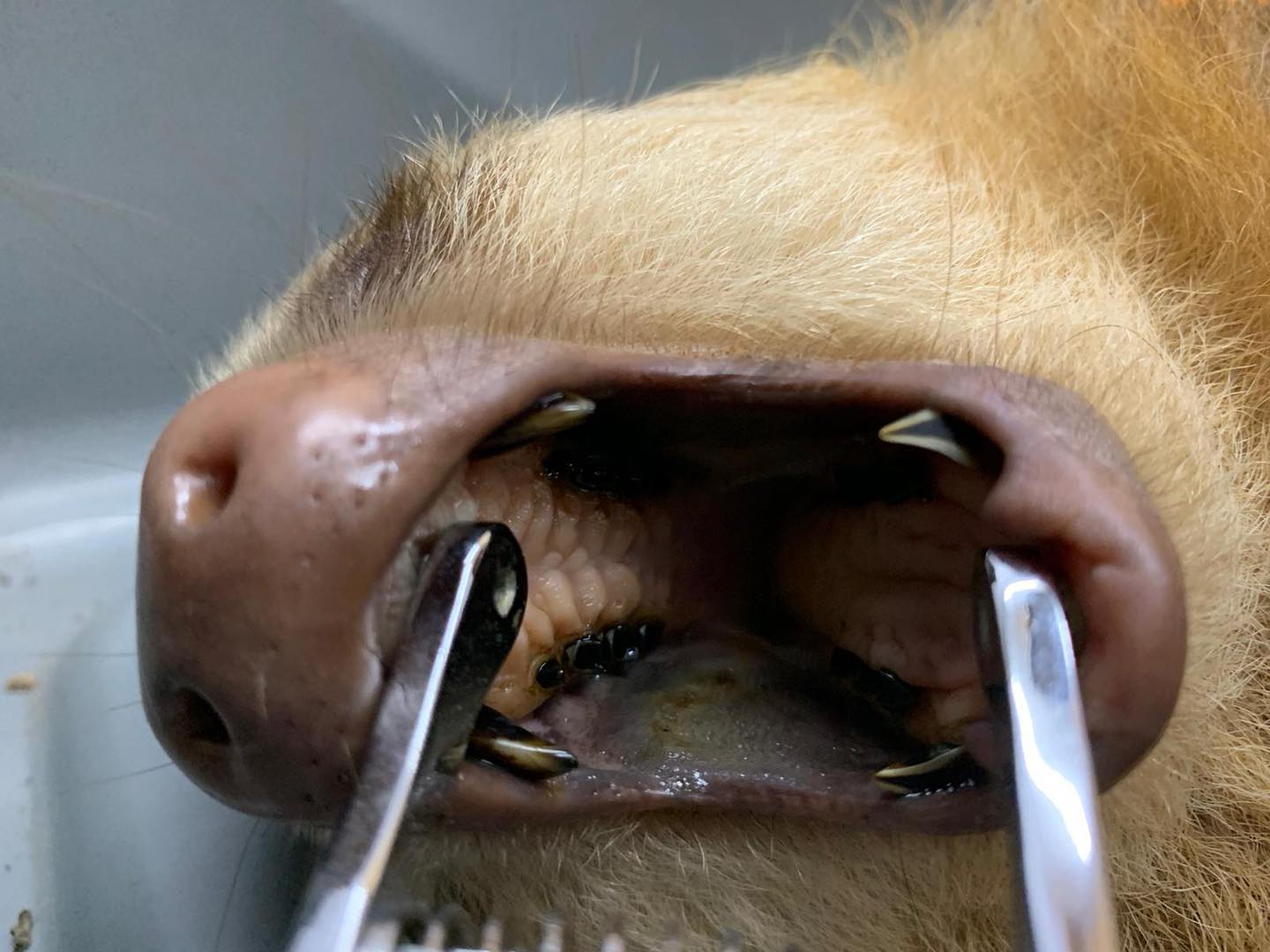
Read More: Are sloths good pets?
Sloth adoptions!
However, you can still symbolically adopt a sloth for you or a loved one! You can choose physical, virtual, or VIP packages! 100% of the proceeds of these adoptions go towards funding our conservation programs to protect sloths in the wild.
Adopt a Sloth

Looking for something else that is full of cute baby sloths? The Official Sloths Wall Calendar, with interesting sloths facts written by Dr. Rebecca Cliffe and adorable photos by wildlife photographer Suzi Eszterhas! Proceeds from the calendar also go directly towards helping sloths in the wild!






